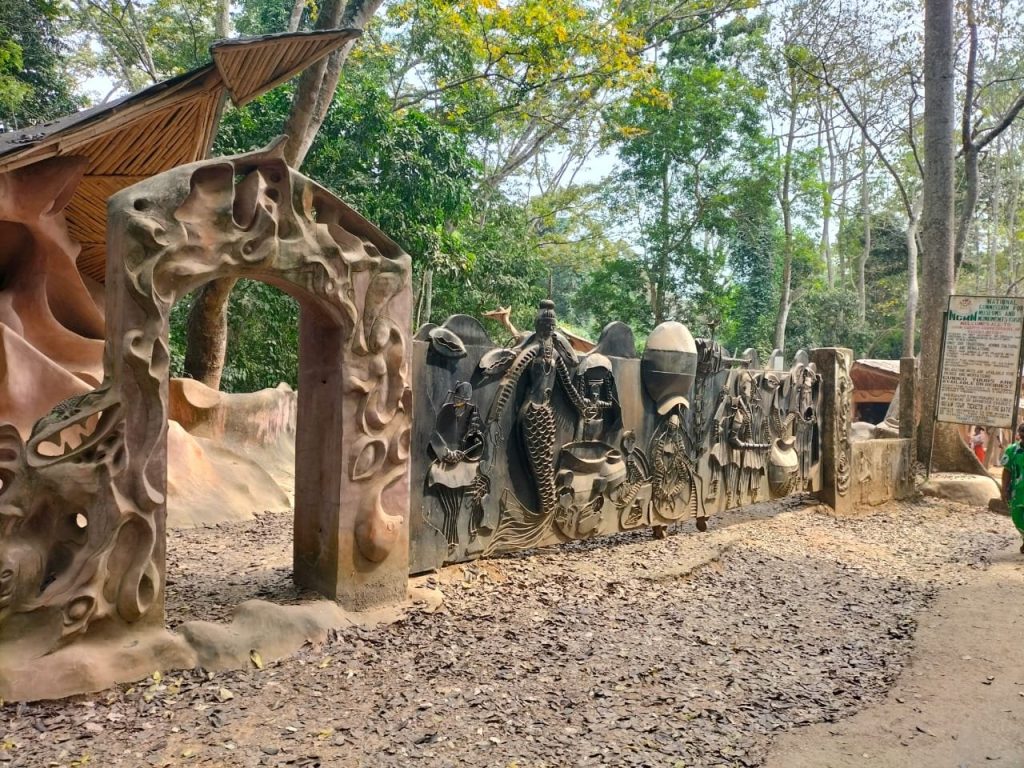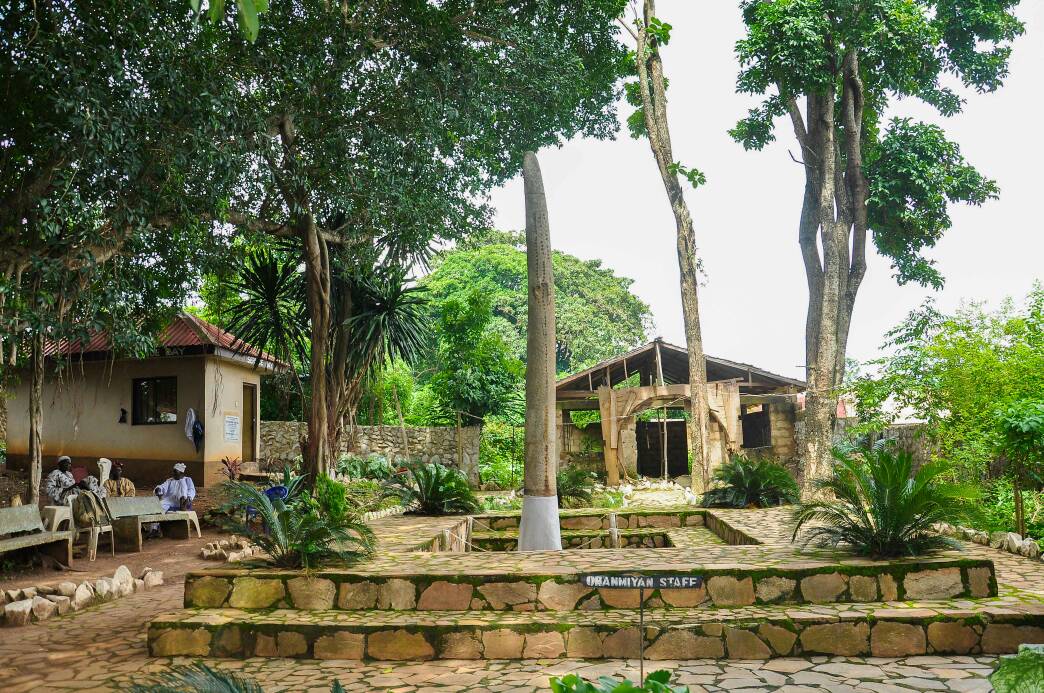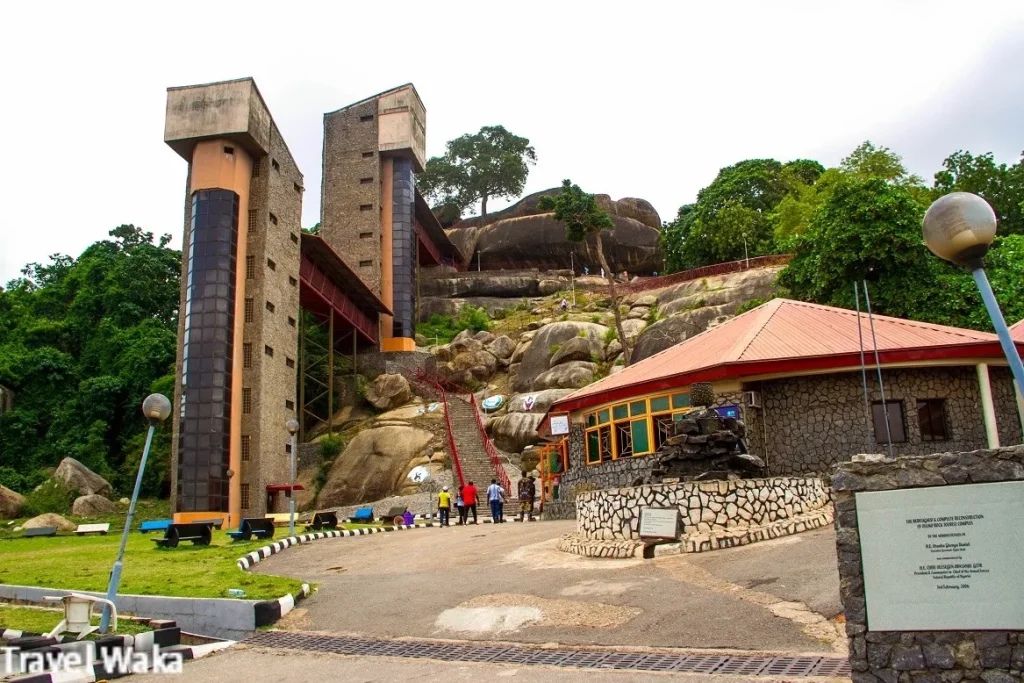Discovering Natural and Cultural Treasures in Nigeria: Osun-Osogbo Sacred Grove, Oranmiyan Staff, Erin-Ijesha Waterfalls, Olumo Rock
The Osun-Osogbo Sacred Grove is a UNESCO World Heritage Site located in Osogbo, the capital city of Osun State, Nigeria. It is a sacred forest along the banks of the Osun River and is dedicated to Osun, the Yoruba goddess of fertility and one of the pantheon of Yoruba deities. The grove is renowned for its rich cultural, historical, and spiritual significance. Here are key points about the Osun-Osogbo Sacred Grove:
- Cultural and Spiritual Importance:
- The grove is a place of worship and veneration dedicated to Osun, who is believed to be the goddess of fertility, healing, and protection.
- History:
- The Osun-Osogbo Sacred Grove has a long history and is believed to have been in existence for several centuries. It has evolved over time with contributions from different generations.
- Annual Osun-Osogbo Festival:
- The Osun-Osogbo Festival is an annual event celebrated at the grove, drawing devotees, tourists, and locals. It is a major cultural and religious festival that involves rituals, processions, and performances.
- UNESCO World Heritage Site:
- The Osun-Osogbo Sacred Grove was inscribed as a UNESCO World Heritage Site in 2005 in recognition of its cultural significance and efforts to preserve its unique ecosystem.

- Sacred Shrines and Art Installations:
- Within the grove, there are sacred shrines, sculptures, and art installations dedicated to Osun and other deities. The art is often created by traditional artists and plays a role in the religious and cultural practices of the community.
- Sacred Ponds:
- The grove features sacred ponds, including the Osun River, which is believed to have healing properties. Pilgrims and visitors may participate in rituals involving the river.
- Role of the Ataoja (King) of Osogbo:
- The Ataoja of Osogbo, the traditional ruler, plays a significant role in the Osun-Osogbo Festival and the maintenance of the grove. The king oversees certain rituals and ceremonies.
- Conservation and Preservation:
- Efforts have been made to conserve and preserve the Osun-Osogbo Sacred Grove. The Osun-Osogbo Festival and the involvement of the community contribute to its protection.
- Tourism and Cultural Heritage:
- The grove attracts tourists, scholars, and cultural enthusiasts interested in experiencing the unique blend of nature, spirituality, and traditional Yoruba culture.
- Cultural Practices:
- Traditional religious practices, including offerings, prayers, and rituals, are conducted within the grove by adherents of the Osun religion.
Visitors to the Osun-Osogbo Sacred Grove can experience the convergence of nature and culture, witness traditional ceremonies, and explore the historical and spiritual aspects of Yoruba religious practices.
Oranmiyan Staff: Myths, Significance, History

The Oranmiyan staff, also known as the Oranmiyan or Staff of Oranmiyan, is a significant symbol in Yoruba history and mythology. It is associated with the legendary figure Oranmiyan, a prince, warrior, and one of the founding fathers of the Oyo Empire. The staff is considered a symbol of authority and represents the lineage of Oranmiyan.
Key Points:
- Oranmiyan and the Oyo Empire:
- Oranmiyan is believed to be a prominent figure in Yoruba history and mythology, associated with the establishment and expansion of the Oyo Empire.
- He is regarded as the son of Oduduwa, the legendary progenitor of the Yoruba people.
- Symbol of Authority:
- The Oranmiyan staff is a ceremonial object that symbolizes the authority and legacy of Oranmiyan.
- It is often depicted as a tall, carved staff or scepter with intricate designs and symbolism.
- Connection to Leadership:
- The staff is closely linked to leadership and royalty in Yoruba culture. It represents the continuity of leadership within the Oranmiyan lineage.
- Cultural Significance:
- The Oranmiyan staff holds cultural and historical significance for the Yoruba people, particularly those with ties to the Oyo Empire.
- It is a tangible representation of the cultural heritage and traditions associated with Oranmiyan.
- Associated Rituals and Ceremonies:
- The staff may be used in various rituals, ceremonies, and events that celebrate the heritage and history of the Yoruba people.
- It is not only a symbol of authority but also a sacred object with spiritual connotations.
- Artistic Representation:
- Oranmiyan staffs are often crafted with artistic detailing, featuring carvings, symbols, and motifs that hold specific meanings within Yoruba cosmology.
- Preservation and Display:
- Some Oranmiyan staffs may be preserved and displayed in cultural institutions, museums, or places of historical significance.
- Tourism and Cultural Heritage:
- The Oranmiyan staff, along with other cultural artifacts, contributes to the tourism and cultural heritage of the Yoruba people. Visitors may encounter these items in museums or cultural centers.
- Local Knowledge:
- For detailed information about specific Oranmiyan staffs, their history, and their significance, consulting with local historians, cultural experts, or community leaders in Yoruba-speaking regions would be valuable.
It’s important to note that cultural symbols and artifacts may vary in interpretation and significance across different communities and regions. For the most accurate and detailed information about the Oranmiyan staff, consulting local sources and experts is recommended.
Erin-Ijesha Waterfalls: Natural Wonder, Osun State

Erin-Ijesha Waterfalls, also known as Olumirin Waterfalls, is a natural waterfall located in Erin-Ijesha, a town in Osun State, southwestern Nigeria. It is one of the most visited and picturesque waterfalls in the country. Here’s some information about Erin-Ijesha Waterfalls:
Location:
Erin-Ijesha Waterfalls is situated in Erin-Ijesha, near the town of Ilesa in Osun State, Nigeria. The exact address and directions can be obtained locally or from tourism offices.
Formation:
The waterfall is a series of cascading falls formed by the Oshun River as it descends from the rocky landscape. The water descends from different levels of rocks, creating a beautiful and captivating natural spectacle.
Accessibility:
While the waterfall is a natural attraction, there are pathways and steps that make it accessible for visitors. The climb to the top of the waterfall involves ascending a series of steps and walking along a designated trail.
Scenic Beauty:
Erin-Ijesha Waterfalls is renowned for its scenic beauty. The surrounding landscape is lush and green, providing a serene environment for visitors to enjoy the sights and sounds of nature.

Cascading Levels:
The waterfall consists of several levels, each with its own pool. Visitors can climb to different levels and enjoy the unique views from various vantage points. The water flows over the rocks, creating a refreshing atmosphere.
Tourist Activities:
- Sightseeing: Visitors can explore the natural beauty of the waterfall, taking in the breathtaking views and enjoying the tranquility of the surroundings.
- Swimming: The pools formed by the cascading water offer visitors the opportunity to swim and cool off in the natural spring water.
- Photography: Erin-Ijesha Waterfalls provides excellent photo opportunities. Visitors often capture the scenic landscapes and the cascading water as lasting memories.
Local Guides:
Local guides are often available to assist visitors, providing information about the waterfall, its geological features, and ensuring a safe and enjoyable experience.
Entrance Fee:
There is typically an entrance fee for visitors to access Erin-Ijesha Waterfalls. The fee helps in the maintenance and preservation of the site.
Before planning a visit to Erin-Ijesha Waterfalls, it’s advisable to check with local authorities or tourism offices for the most up-to-date information regarding entrance fees, operating hours, and any guidelines for visitors.
Olumo Rock: Tourist Attraction, Abeokuta, Ogun State

Olumo Rock is a notable tourist attraction located in Abeokuta, the capital city of Ogun State, Nigeria. It is a historical and cultural landmark with great significance. Here’s some information about Olumo Rock:
Location:
Olumo Rock is situated in the heart of Abeokuta, making it easily accessible for visitors. Abeokuta itself is located in the southwestern part of Nigeria.
Geological Formation:
- Olumo Rock is a massive granite rock formation that rises 137 meters above sea level. It has natural caves, tunnels, and unusual rock formations.
Historical Significance:
- Olumo Rock has historical importance, as it served as a natural fortress for the Egba people during inter-tribal wars in the 19th century.
- The name “Olumo” translates to “Under the rock” in the Egba language, which is fitting given its historical role as a place of refuge.
Tourist Attraction:
- Olumo Rock has become a popular tourist attraction, drawing visitors from within Nigeria and around the world.
- Visitors can climb the rock to explore its caves, tunnels, and enjoy panoramic views of the surrounding landscape.
Cultural Significance:
- The rock holds cultural significance for the Egba people. There are shrines, sculptures, and artifacts at the base of the rock that reflect the cultural heritage of the region.
- The summit of Olumo Rock offers a great vantage point to appreciate the cultural and historical landscape of Abeokuta.
Access and Climbing:
- Olumo Rock is accessible to tourists, and there are paved pathways and steps that make the climb to the top manageable.
- The climb to the top is not overly strenuous, and visitors are rewarded with breathtaking views.

Tourist Facilities:
- There are tourist facilities at the base of Olumo Rock, including a museum that provides insights into the history and culture of the Egba people.
- Souvenir shops are also available where visitors can purchase traditional crafts and memorabilia.
Ceremonies and Festivals:
- Olumo Rock is sometimes a venue for cultural events, ceremonies, and festivals, adding to its vibrancy and cultural appeal.
Local Guides:
- Local guides are often available to provide information about the history, folklore, and cultural significance of Olumo Rock.
Before planning a visit to Olumo Rock, it’s advisable to check for any specific guidelines, entrance fees, or other relevant information. The rock is not only a geological wonder but also a site deeply embedded in the cultural and historical fabric of the region.

